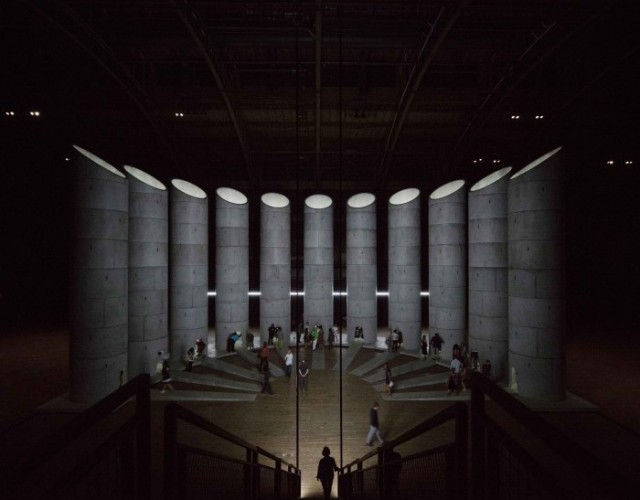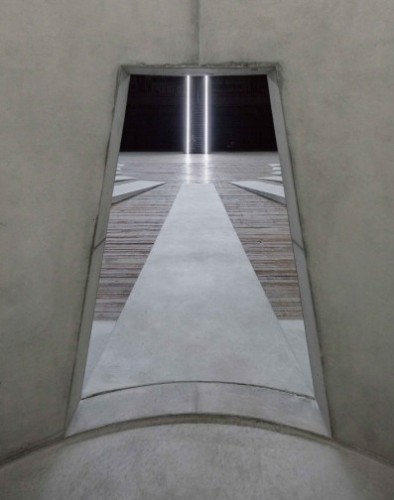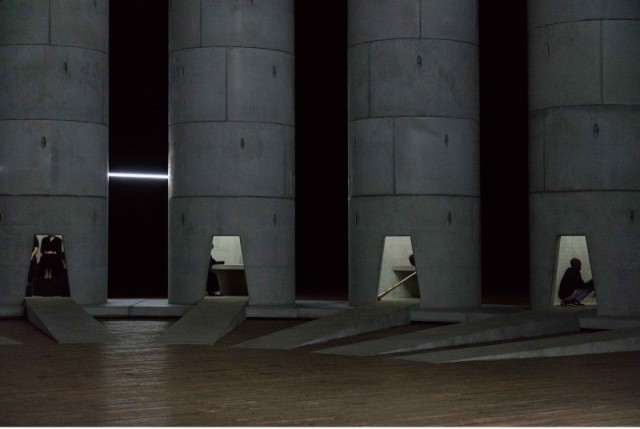
Taryn Simon’s Park Ave. Armory installation resembles both a memorial pipe organ and a semicircle of crematorium chimneys (photo © Naho Kubota)
Park Ave. Armory
643 Park Ave. between 66th & 67th Sts.
September 13-25, daytime installation: Tuesday – Sunday, $10, 12 noon – 4:00
September 13-25, evening performances: Tuesday – Sunday, $45, 6:20, 7:10, 8:00, 8:50, 9:40, 10:30, 11:20
212-933-5812
www.armoryonpark.org
tarynsimon.com
New York–based conceptual artist Taryn Simon has primarily used text and image and exhaustive research to document, collect, catalog, categorize, and classify multiple aspects of the human condition, examining such issues as politics, justice, governance, immigration, economics, and religion in such previous works as “A Living Man Dead and Other Chapters I-XVIII,” “Contraband,” “Paperwork and the Will of Capital,” and “An American Index of the Hidden and Unfamiliar.” In her latest piece, “An Occupation of Loss,” Simon takes on all that and more in a compelling and deeply involving interactive performance installation continuing its world premiere at the Park Ave. Armory through September 25. Co-commissioned by the armory and London’s Artangel, “An Occupation of Loss” is an intimate exploration of the ritual of grief and the marginalization of professional mourners. Each evening, there are seven thirty-five-minute performances that begin with a group of fifty ticket holders waiting outside the armory on Sixty-Seventh St. At the designated start time, they are led up the stairs and into the massive Wade Thompson Drill Hall, where they line up on the balcony, overlooking eleven forty-eight-foot concrete wells (composed of eight six-foot rings apiece), arranged in a semicircle, each with a walkway leading to a small entrance. Slowly and quietly, up to three professional mourners enter each structure (designed by OMA / Shohei Shigematsu for maximum acoustical effect), which evoke Zoroastrian Towers of Silence as well as crematorium chimneys and a pipe organ. The audience is then led downstairs onto the floor of the 55,000-square-foot drill hall, through two long, narrow vertical white lights that echo the “Tribute in Light” homage to the Twin Towers (the lighting is by Urs Schönebaum), and are then permitted to enter the small, tight-fitting spaces where the mourners perform their laments. Wearing traditional clothing (except for a trio of Greeks who are in contemporary dress), the men and women sing, chant, cry, wail, and play instruments as they would at a funeral in their native country; however, in this case, since they are not mourning for any specific person, it is as if they are mourning for us all. “I was looking at the space that grief and loss generate and how it is performed and that line between something that is scripted and authentic,” Simon explains in an armory video, “and how we process that when the object of loss is not present — when there’s no body at the center. Is there a space where one actually has individual emotion, and where are our emotions governed and part of a program, and when are they liberated and something of our own? And questioning if that space even exists.” In addition to the evening performances ($45), the installation will be open Tuesday through Sunday from noon to four o’clock ($10), when visitors can walk around the wells and lament in their own way without the professional mourners, who only appear at night. The piece challenges viewers to consider such dualities as life and death, absence and presence, sound and silence, day and night, bona fide and staged, the private and the public, and light and dark.

Taryn Simon’s “An Occupation of Loss” offers a fascinating look at how several cultures deal with grief in a public setting (photo © Naho Kubota)
As detailed in a booklet that visitors receive on their way out, the mourners come from Burkina Faso, India, Azerbaijan, Greece, France, Cambodia, Ghana, Ecuador, China, Romania, Russia, Malaysia, and Venezuela. The extensive information Simon had to provide in order to get the performers nonimmigrant visas forms a fascinating overview of their historic and cultural context. For example, Dr. Boureima T. Diamitani writes, in support of Burkina Faso mourners known as masks, “For many years, performers of mourning rituals are taught sacred practices to protect them from malefic powers of external enemies.” Dr. Sarah Laursen notes, “It is also customary throughout China to hire professional mourners to inspire attendance at funeral ceremonies, as it is believed that the number of attendees at a funeral is reflective of the importance of the deceased in the community.” And Juan Mullo Sandoval points out, “Along with its poetic structure and morphological system, the telluric, sentimental, and lamentation aspects of yaravíes represent the affliction that has characterized marginal sectors of the Ecuadorian population since the colonial times: problems of exclusion, economic deprivation, and exploitation.” “An Occupation of Loss” is particularly poignant in the wake of last weekend’s fifteenth anniversary of the 9/11 attacks, but there’s a timeless quality to it as well, given the many military actions going on around the globe right now, the frightening number of mass shootings in America, the fierce battle over immigration, and the national controversy over the killings of unarmed black men, women, and children by white police officers. Also, Simon was very careful to omit the graceful ambience of the armory, with its decorated period rooms, portraits, and plaques honoring veterans and military dead, from visitors’ experience. Thus, no one exits or enters through the main lobby; instead, a side and back door are used, allowing the installation to stand on its own. “An Occupation of Loss” might be about death and grief, but it is also a celebration of unique and different cultures at a moment when fear of the other is so prevalent in America’s psyche, and Simon doesn’t want anything else to get in the way of that.

Visitors can enter small spaces where professional mourners perform their laments (photo © Naho Kubota)
The thirty-five minutes pass by very fast, so be sure to save some time to relax near the center of the semicircle, where all of the sounds of mourning come together to form an entrancing cacophony of lament. You will then be led out through a surprise exit that will delight those who attended the armory’s previous exhibition, Martin Creed’s “The Back Door.” And the booklet itself is also extremely worthwhile, identifying each of the professional mourners and sharing engrossing information on their specific forms of lamentation and how they relate to social, political, and economic issues in their country; over the years, many of the mourners have risked their own lives in order to help honor those that have already lost theirs, adding yet more power to this wholly original experience. [Note: Simon will be at the armory on September 24 for an artist talk moderated by scholar Homi K. Bhabha ($15, 6:00).]